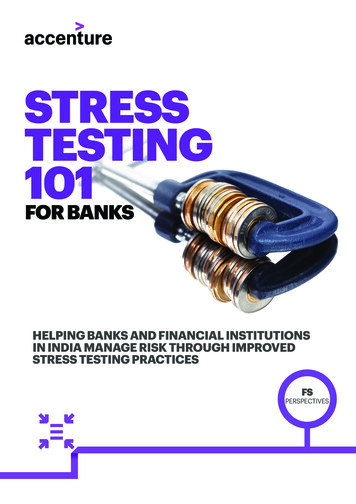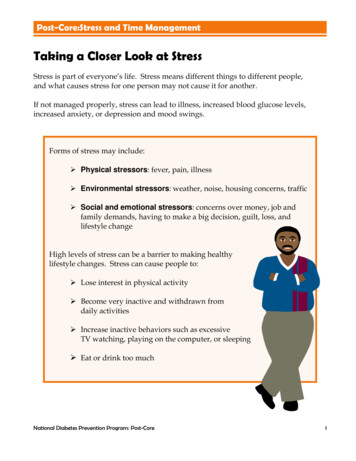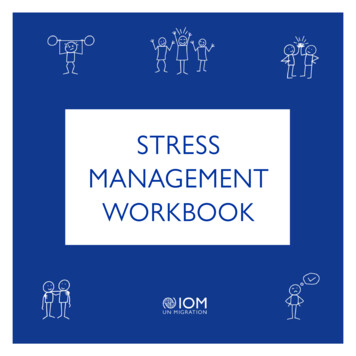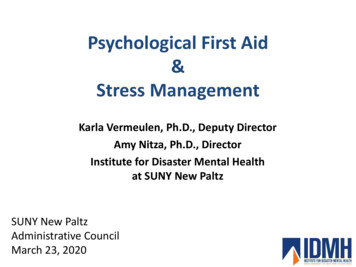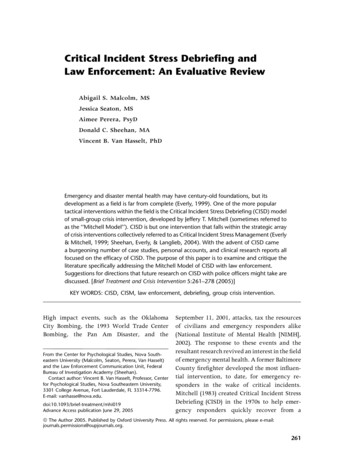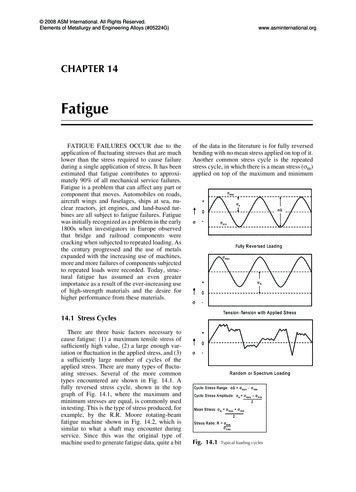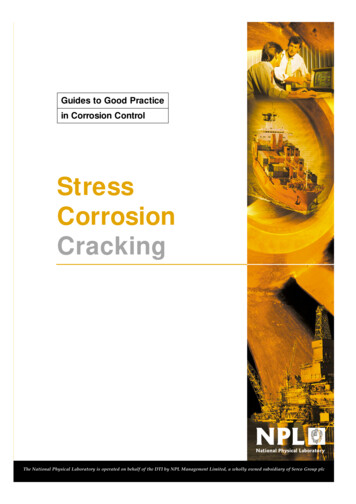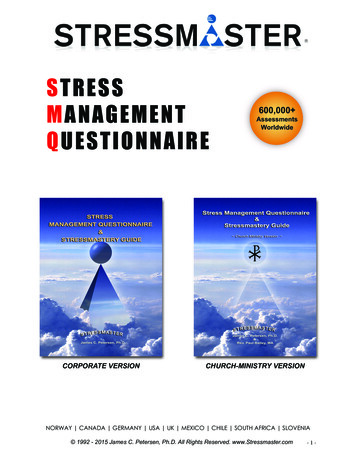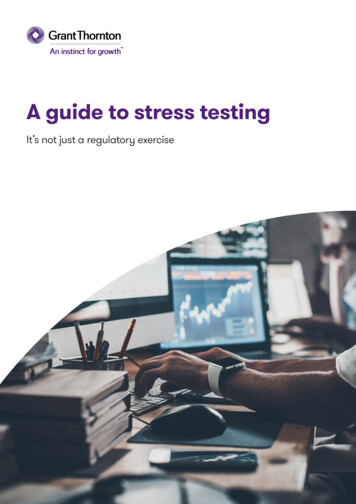
Transcription
A guide to stress testingIt’s not just a regulatory exercise
ContentsMaximising the value of stress testing3Following a three stranded approach to stress testing5Meeting regulatory expectation6Building the scenario7Applying the results of the stress test9How we can help10
Maximising the valueof stress testingThe banking crisis shook the global economy and thelast ten years have been characterised by consistentregulatory efforts to prevent it from happening again.Stress testing is a valuable part of those efforts and is anessential tool for viewing the bigger picture.Ian MortonAssociate DirectorBusiness Risk ServicesWhile stress testing programmes are nothing new, they are often poorly embeddedinto broader risk management processes. But they can be a vital tool to identifykey dependencies across the business and help identify under-capitalised or at riskbusinesses. This can strengthen the risk management framework, which is particularlyimportant for the globally systemic banks on whom the economy depends.Although there are a number of regulatory drivers pushing the stress testing agenda, itwould be short sighted to view it as a simple box ticking exercise. Stress testing can bea valuable tool to assess how a business will fare in the face of change. These changesmay be pre-planned organisational growth or restructuring, or unavoidable changesdue to external factors. Either way, putting together potential business scenarios andtesting against them can identify emerging risks and improve business resilience in thelong term.But what should those scenarios be? This is perhaps the most challenging area ofstress testing and one that can be limited by a lack of imagination. Testing scenariosshould be extreme, catastrophic and truly relevant to the business. If the market hasbeen stable for some time, it can be difficult to imagine the worst case scenarios, but itis important to do so. Effective stress testing should identify unknown weaknesses andstrengthen the control framework moving forward.Essentially stress testing is a forward looking exercise. But it can be difficult to apply thefindings. What do they really mean? What changes are needed across the business?This is where senior management input is vital from the word go. There’s no pointidentifying these issues without the decision making power to implement the necessarychanges. So it is important to really think through the stress testing programme in termsof ownership, intended benefits and how this is practically fed back into the existing riskmanagement framework.Stress testing 3
4 Stress testing
Following a three strandedapproach to stress testingFirms need to establish comprehensive stress testing programmes that accuratelyassess their business health and how they would cope in the face of another financialcrisis. To achieve this, stress testing should be considered in three key strands, asoutlined below.Not only must they meet regulatory expectation, but firms must create a plausible (yet extreme) scenario and effectively apply theirfindings to the business moving forward.Meeting regulatory expectation Firms subject to Basel basedregulations are expected toperform stress testing on the keyareas of the business at leastannually. Stress testing is a regulatoryrequirement for inclusion in theICAAP and ILAAP, and feeds intothe recovery and wind-downplans. Banks across Europe are requiredto participate in the EuropeanBanking Authority’s stress testingexercises.Building the scenario The scenario should offer valuableinsight into future uncertainty,both within the business andfrom market change. It shouldbe forward looking in nature andinclude elements such as the effectof digital entrants to the market. A strong scenario should alsorobustly test for key businessvulnerabilities (such asconcentration risk), which canbe identified by examining thecorrelation and interaction betweendifferent elements of the business.Applying the resultsof the stress test Drawing on the output of thestress test, firms should factortheir findings back into therisk profile to inform their riskmanagement processes. Anticipation of adverse eventshelps businesses to be proactiveand become more effective undera variety of conditions, thereforeimproving their chances ofsurvival. Failure to run adequate stresstests can lead to additionalcapital or liquidity requirements.Who does stress testing apply to?Stress testing is applicable to a broad range of financial institutions including banks of all types, fund managers, insurers, brokersand security houses. A variety of risk areas may be assessed through stress testing, such as: Liquidity risk FRTB Net interest income Credit risk IFRS 9 ICAAPs Operational continuity in resolution Market risk Model risk ILAAPs Recovery planning Operational riskStress testing 5
Meeting regulatoryexpectationIn recent years, there has been an increasing global trend towards stress testingprogrammes. Spearheaded by BCBS’s ‘Principles of Sound Stress Testing Practices andSupervision’ guidance paper, banks, insurers and other financial institutions around theworld are now required to maintain a comprehensive stress testing programme.The results of these are used to measure whether they havesufficient capital and liquidity to endure adverse conditions.Relevant geographical regulations, requiring outputs for stresstesting purposes include:Central banks across the globe run regular stress testingexercises to assess if the banks they govern are robustenough to withstand future shocks. These tests are becomingincreasingly sophisticated, and assess:Geographic regionTypical regulationsGlobalBasel PrinciplesUSADodd-Frank Act (DFAST), CCAR A range of metrics in addition to the capital contagioneffect across marketsEuropeCRD IV, EBAUKSYSC 20, PRA Rulebook, FCAHandbook, Solvency II The impact of globalisation on contagion The use of relevant stress scenarios in day to day riskmanagement processes and reportingWhere banks do not meet the minimum criteria followinga stress test, firms may be asked to bolster their capital.Stress testing modelsRegulatory changeThe PRA has acknowledged the risks posed to effectivestress testing by inadequate models and has introduced thefollowing four principles:Regulations around stress testing continue to evolve:Principle 1 – Banks have an established definition of a modeland maintain a model inventory.Principle 2 – Banks implement an effective governanceframework, policies, procedures and controls to managetheir model risk.Principle 3 – Banks implement a robust model developmentand implementation process and ensure appropriate use ofmodels.Principle 4 – Banks undertake appropriate model validationand independent review activities to ensure soundmodel performance and greater understanding of modeluncertainties.6 Stress testing Stress testing principles: In December 2017, BCBS issueda consultative document regarding nine stress testingprinciples to replace the previous 21. Recovery planning: The PRA have detailed the changes inapproach toward stress testing in recovery situations. TheEBA also issued a paper on the use of scenarios in therecovery plan. Pillar 2A: The PRA consultation paper on Pillar 2A capitalrequirements expressed the need for the output of stressscenarios to be incorporated into these calculations. The PRA have issued a supervisory statement on dealingwith a market turning event in the general insurancesector, which introduces stress testing and reverse stresstesting.
Building the scenarioA stress test considers a plausible scenario and assesses an organisation’s ability torespond to it. Testing is most effective when based on extreme scenarios and as such, alack of imagination can be a limiting factor.Idiosyncratic and systemic riskSelecting an appropriate range of scenarios and models iscrucial to understanding vulnerabilities and risk interactionsacross the business. Building the scenario can be timeconsuming and requires input from a wide range of areaswithin the organisation.Stress testing scenarios should address one of two types ofrisk factor, idiosyncratic and systemic.Systemic risk refers to scenarios which are market driven andmay affect all organisations, for example Brexit.Key elements required to build scenarios include:Idiosyncratic risks are those which are specific to a particulartype of business, such as Russian banks operating underregulatory restrictions. A realistic methodology/approach Justifiable assumptions Effective challenge by senior management The ability to reproduce scenarios at short notice The ability to apply the output of scenarios to day-to-dayrisk managementWhen building scenarios, it is important to consider bothidiosyncratic and systemic risk factors. Alignment with regulatory expectations and parameters The ability to tease out elements of the business (egportfolios) which are particularly sensitive to variousmacro-economic factorsAs with any type of assessment, stress testing should haveclearly identifiable inputs and useable outputs. They shouldhave significant senior oversight and be subject to robustchallenge, as outlined below.Oversight and challenge by senior managementInputsCriteria fromthe regulatorData frombusiness models,business strategyand economicforecastsOutputsStress testmodelsAssumptionsRegulatoryreturnsRegular MI forthe businessInputs into riskappetite andlimitsStress testing 7
Building the scenario (cont.)Case studyBuilding challenging scenariosOur client developed a number of stress testing scenariosto assess the adequacy of their capital and liquidityresources. The stress testing scenarios were too simplisticand the organisation struggled to meet reverse stresstesting requirements to develop a scenario that wouldchallenge the business’ existence. We reviewed andchallenged the client’s business model, strategies andforecasts and helped to create an inventory of relevant,severe scenarios. Our team helped senior management toidentify and mitigate risks within the organisation.8 Stress testingCase studyAssurance over stress modelsOur client sought assurance over their regulatoryalignment and the soundness of the model employed fortheir EBA 2018 stress test. We designed the assuranceframework, including the compliance template for ourclient to align to the each area of regulatory focus.Our experts offered meaningful challenge across allrisk areas and provided an opinion on overall EBAcompliance in relation to stress testing for all risk areas.
Applying the results of thestress testStress testing is designed to improve a bank’s resilience by checking the effects ofchanging internal or external risk factors. It is not enough to simply conduct a stresstest, senior management must analyse the outcome and use the findings to furthermitigate risk.Senior management buy-in is integral to stress testing, fromplanning through to mitigating the identified risks. Successfulmitigation of the stress scenarios depends on the following: Instigating a range of precautionary measures andcontingency plans in the event of worsening conditions Promptly implementing new controls, as required Measuring the effectiveness of improved controls andestablishing Key Risk Indicators based on trend analysis Assessing the possible impact of those controls Maintaining oversight and effective risk management Weighing up the cost of implementing new processesCommon challengesKey challenges firms face when conducting stress testing exercises include: Selecting scenarios which have no relationship to the business Taking longer than competitors to run or re-run stress scenarios Not taking the impact of stresses into daily risk management Not preparing plans to mitigate the effects of the stress scenarios Not creating sufficiently adverse scenarios (also highlighted by the regulators)Meeting regulatory expectationRegulators expect stress testing to systematically challengeexisting and accepted risk management techniques across anorganisation. This challenge should take into account stressedconditions such as illiquid markets, which could delay oreliminate any benefit from these actions.Best practice is to rank the effectiveness of mitigating controlsas follows: Effective notwithstanding any stressed conditions Delay in the effectiveness caused by stressed conditions Severely impacted by stressed conditionsCase studyHelping our client to respond to the results of stress testingFollowing an ICAAP submission, the regulators noted that certain scenarios would put our client out of business and thatno mitigating controls had yet been established. This had a direct impact on their capital buffer. We assisted our client byestablishing feasible mitigation plans in the event of the scenarios taking place in real life. The approach was consistent withrecovery planning and was considered by the regulators at their next SREP visit.Stress testing 9
How we can helpStress testing is more than a regulatory requirement and can be a valuable tool toidentify emerging or overlooked risks across a business. Forward looking in nature,they should model severe scenarios to identify vulnerabilities and areas where furthercontrols are needed to mitigate risk.Our experts can help you to devise challenging and realisticscenarios, which offer genuine insight into your business.Drawing on significant experience across the financial sector,our team of finance and risk experts can advise on best practiceincluding the type and combination of stress tests to be applied.We can help you interpret the results of the stress test and workwith management to implement mitigating controls as required.Our team can support your business in the following areas:testing across the key risks and addressing the challengesof FRTB and the moves to standardise counterparty andoperational risks Offer assurance, benchmarking and updates on the latestregulatory direction and changes Help manage the latest challenges to the Pillar 2A capitalrequirements Help create realistic stress scenarios from our marketexperience Assess the overall effectiveness of the model riskmanagement framework in terms of the PRA’s SupervisoryStatement. We will evaluate and independentlyverify whether model risk management practices arecomprehensive, rigorous, and effective Support to create a realistic inventory of scenarios andupdating these as circumstances change Provide assurance to life and non-life insurers on theirapproach to stress testing Help design and implement an effective and proportionatestress testing framework Provide a consistent and proportionate approach to stressContact usSandy KumarHead of Financial Services Groupand Business Risk Services UKT 44 (0)20 7865 2193E sandy.kumar@uk.gt.comIan MortonAssociate DirectorBusiness Risk ServicesT 44 (0)20 7865 2432E ian.p.morton@uk.gt.com10 Stress testingPaul YoungManaging DirectorBusiness Risk ServicesT 44 (0)20 7865 2781E paul.l.young@uk.gt.com
Stress testing 11
2018 Grant Thornton UK LLP. All rights reserved.‘Grant Thornton’ refers to the brand under which the Grant Thornton member firms provide assurance,tax and advisory services to their clients and/or refers to one or more member firms, as the context requires.Grant Thornton UK LLP is a member firm of Grant Thornton International Ltd (GTIL). GTIL and the member firms arenot a worldwide partnership. GTIL and each member firm is a separate legal entity. Services are delivered by themember firms. GTIL does not provide services to clients. GTIL and its member firms are not agents of, and do notobligate, one another and are not liable for one another’s acts or omissions. This publication has been preparedonly as a guide. No responsibility can be accepted by us for loss occasioned to any person acting or refrainingfrom acting as a result of any material in this publication.grantthornton.co.ukGRT109024
Credit risk ICAAPs Market risk ILAAPs Operational risk. 6 Stress testing Meeting regulatory expectation In recent years, there has been an increasing global trend towards stress testing programmes. Spearheaded by BCBS's 'Principles of Sound Stress Testing Practices and
